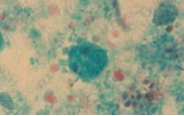Deck 4: Protozoa: Amoeba
Question
Question
Question
Question
Question
Question
Question
Question
Question
Question
Question
Question

Unlock Deck
Sign up to unlock the cards in this deck!
Unlock Deck
Unlock Deck
1/12
Play
Full screen (f)
Deck 4: Protozoa: Amoeba
1
An Entamoeba histolytica trophozoite may be identified by which of the following morphologic features?
A) Ingested RBCs and a single nucleus with a central karyosome
B) Ingested RBCs and a single nucleus with an eccentric karyosome
C) Ingested RBCs, a single nucleus, and a large cytoplasmic glycogen vacuole
D) Ingested WBCs and two nucleoli with central karyosomes
A) Ingested RBCs and a single nucleus with a central karyosome
B) Ingested RBCs and a single nucleus with an eccentric karyosome
C) Ingested RBCs, a single nucleus, and a large cytoplasmic glycogen vacuole
D) Ingested WBCs and two nucleoli with central karyosomes
Ingested RBCs and a single nucleus with a central karyosome
2
Entamoeba histolytica can be differentiated from E. dispar based on differences in the:
A) Size of the cyst
B) Number of nuclei in the cyst
C) Location of the karyosome
D) None of these. The organisms cannot be differentiated morphologically.
A) Size of the cyst
B) Number of nuclei in the cyst
C) Location of the karyosome
D) None of these. The organisms cannot be differentiated morphologically.
None of these. The organisms cannot be differentiated morphologically.
3
Entamoeba histolytica can be differentiated from E. hartmanni based on differences in the:
A) Size of the cyst
B) Number of nuclei in the cyst
C) Location of the karyosome
D) None of these. The organisms cannot be differentiated morphologically.
A) Size of the cyst
B) Number of nuclei in the cyst
C) Location of the karyosome
D) None of these. The organisms cannot be differentiated morphologically.
Size of the cyst
4
The most prominent morphologic feature used to identify Iodamoeba bütschlii is:
A) A large glycogen mass
B) Four nuclei with large karyosomes
C) Ingested bacteria
D) Pointed chromatoidal bars
A) A large glycogen mass
B) Four nuclei with large karyosomes
C) Ingested bacteria
D) Pointed chromatoidal bars

Unlock Deck
Unlock for access to all 12 flashcards in this deck.
Unlock Deck
k this deck
5
Drainage from an oral gum lesion revealed the presence of a possible amoeba. An amoeba with a single nucleus and ingested WBCs was noted in a trichrome-stained preparation of the drainage material. Which of the following is the probable parasite found in this sample?
A) Entamoeba histolytica/dispar
B) Entamoeba gingivalis
C) Entamoeba polecki
D) Trichomonas tenax
A) Entamoeba histolytica/dispar
B) Entamoeba gingivalis
C) Entamoeba polecki
D) Trichomonas tenax

Unlock Deck
Unlock for access to all 12 flashcards in this deck.
Unlock Deck
k this deck
6
A permanently stained fecal smear revealed several cysts containing eight nucleoli that had clumped chromatin and eccentrically located karyosomes. The likely identity of this parasite is:
A) Dientamoeba fragilis
B) Endolimax nana
C) Entamoeba coli
D) Entamoeba histolytica
A) Dientamoeba fragilis
B) Endolimax nana
C) Entamoeba coli
D) Entamoeba histolytica

Unlock Deck
Unlock for access to all 12 flashcards in this deck.
Unlock Deck
k this deck
7
A 10-year-old boy with symptoms of meningitis and a history of swimming in his farm pond was brought to the hospital emergency department. Examination of his CSF revealed motile amoeba measuring 12 µm in diameter. The most likely parasite is:
A) Acanthamoeba spp. trophozoites
B) Dientamoeba fragilis trophozoites
C) Endolimax nana trophozoites
D) Naeglaria fowleri trophozoites
A) Acanthamoeba spp. trophozoites
B) Dientamoeba fragilis trophozoites
C) Endolimax nana trophozoites
D) Naeglaria fowleri trophozoites

Unlock Deck
Unlock for access to all 12 flashcards in this deck.
Unlock Deck
k this deck
8
The parasite most often associated with contaminated contact lens cleaning solution is:
A) Acanthamoeba spp.
B) Dientamoeba fragilis trophozoites
C) Endolimax nana trophozoites
D) Naeglaria fowleri trophozoites
A) Acanthamoeba spp.
B) Dientamoeba fragilis trophozoites
C) Endolimax nana trophozoites
D) Naeglaria fowleri trophozoites

Unlock Deck
Unlock for access to all 12 flashcards in this deck.
Unlock Deck
k this deck
9
A cyst measuring 25 µm in diameter was observed in a fecal smear. It contained a large, clear central vacuole with four homogeneous nuclei lying outside the vacuole near the cyst wall. This parasitic form suggests the presence of:
A) Blastocystis hominis
B) Endolimax nana
C) Iodamoeba bütschlii
D) Trichomonas tenax
A) Blastocystis hominis
B) Endolimax nana
C) Iodamoeba bütschlii
D) Trichomonas tenax

Unlock Deck
Unlock for access to all 12 flashcards in this deck.
Unlock Deck
k this deck
10
The free-living amoeba associated with meningitis is:
A) Dientamoeba fragilis
B) Entamoeba coli
C) Entamoeba histolytica
D) Naegleria fowleri
A) Dientamoeba fragilis
B) Entamoeba coli
C) Entamoeba histolytica
D) Naegleria fowleri

Unlock Deck
Unlock for access to all 12 flashcards in this deck.
Unlock Deck
k this deck
11
Name the parasite shown in the following image: 
A) Entamoeba coli
B) Entamoeba dispar
C) Entamoeba hartmanni
D) Entamoeba histolytica

A) Entamoeba coli
B) Entamoeba dispar
C) Entamoeba hartmanni
D) Entamoeba histolytica

Unlock Deck
Unlock for access to all 12 flashcards in this deck.
Unlock Deck
k this deck
12
Name the parasite shown in the following image: 
A) Dientamoeba fragilis
B) Entamoeba coli
C) Entamoeba hartmanni
D) Iodamoeba bütschlii

A) Dientamoeba fragilis
B) Entamoeba coli
C) Entamoeba hartmanni
D) Iodamoeba bütschlii

Unlock Deck
Unlock for access to all 12 flashcards in this deck.
Unlock Deck
k this deck



